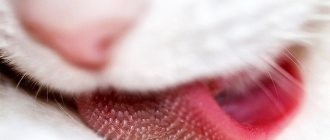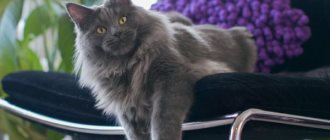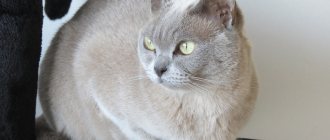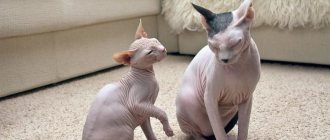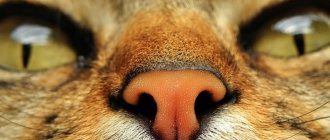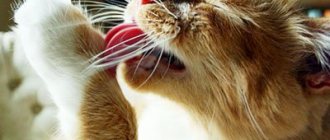Main functions
A cat's whiskers, otherwise called whiskers, are the most important organ of touch. Through the nerve endings located on them, the received information enters the brain.
They perform the following functions:
- Helps to navigate in space. Everyone knows that cats move without bumping into objects even in complete darkness. In this they are helped not only by their visual organs, but also by their whiskers, which allow them to determine the size and distance to objects. Thanks to the vibrissae, they reliably understand whether they can pass through a small opening or not.
- Food analysis. In addition to the sense of smell and mouth, vibrissae are also involved in assessing the properties of food: its freshness, taste, temperature and safety.
- For hunting. They allow you to detect the slightest movements of the victim, even if it is very far away. They also make it clear whether the potential victim is alive or not.
- For communication. The disposition to communicate can be seen by their location. If the cat is irritated and does not want to be touched, then he will press them to his face. Fluffy, twitching and sticking out always signal readiness for games and a good mood.
Main functions of the mustache
Need for a haircut
During life, whiskers, like ordinary hair, grow, age, and fall out, but new ones will certainly grow in place of those that fall out, and only in old cats does this process slow down, as does the activity of the animal itself. If you deliberately trim a cat's whiskers, you can assume that she has switched off an important organ that helps her survive.
Soon the new whiskers will grow, and she will be able to feel good again, but without them it is extremely difficult for the cat. Cutting it off can cause incredible pain to your pet, because the whiskers are very sensitive to touch.
Studies have revealed the following behavioral problems in animals with trimmed whiskers:
- Orientation in space has worsened, especially at night.
- The ability to assess the size of holes in relation to the size of one’s own body has decreased.
- Some cats, after trimming their whiskers, looked scared, were aggressive, and their behavior became inappropriate.
- It has been observed that the smartest cats bite off the whiskers of their relatives in order to subjugate them.
- The ability to estimate the distance to an object to make a jump is reduced.
But, like any rule, there are exceptions. Sphynx cats have either few or no whiskers, but this does not prevent them from navigating in space and hunting.
Vibrissae structure
The roots of the mustache are located deep in the tissues. They are equipped with nerve endings. The information received is sent to the brain and changes the animal’s behavior.
The largest part is located on the muzzle in four rows. On average there are 24 of them. The length of each reaches approximately 6-7 cm. For individual breeds, the value can vary significantly up or down.
The Guinness Book of Records has recorded the longest 19-centimeter mustache on a representative of the Maine Coon breed.
Outbred cats turn out to be better hunters the longer their whiskers are. It has been noticed that skinny cats have thinner hair than well-fed ones.
In addition to the cheeks, vibrissae are located on the chin, above the eyes, on the tail and paws. They are much shorter, but have the same purpose.
What does the absence of a mustache lead to?
The loss of a cat's whiskers directly affects not only its mood, but also its behavior and life in general. As mentioned earlier, the whiskers in cats are directly connected to the nerve endings, and this has a certain impact on the character of the cat that is forced to live without a whisker.
With the absence of whiskers, cats, of course, do not die, but, nevertheless, they are deprived of an important sensory organ. Many actions, such as hunting, navigation, movement, become much more difficult to perform. In this regard, when a cat loses its whiskers, it becomes lost, nervous, and aggressive. Until the whiskers grow back (this is a rather long process), she is in constant stress, and this is very harmful to the health of the animal. So, cats without whiskers have a very difficult life psychologically.
© shutterstock
Is it possible to trim a cat's whiskers?
Like other hairs, they gradually die and fall out, and new ones grow in their place. This process occurs throughout life and does not stop even in old age. Over time, they thicken, darken and gradually begin to turn gray. A fallen tendril is often only half colored. In addition, its end is generally very sharp. In older pets, the rate of replacement after loss slows down significantly.
Trimming a cat's whiskers is strictly prohibited! If you do this, they will grow back very slowly. In addition, the entire period of their regrowth will be quite difficult for animals to tolerate.
Vibrissae
Scientists have even conducted research by cutting off whiskers and observing changes in behavior. Some representatives continued to behave as usual, but most were scared and confused. At the same time, all experimental subjects had the following problems:
- Poor orientation in dark places and bumping into things around them.
- Getting stuck in narrow passages more often due to the inability to objectively assess their dimensions.
- Reduced jumping accuracy. They did not reach or landed on the side of the objects they planned to jump on.
- For cats that are only at home, this is not so scary. But for pets going outside, this is fraught with unpleasant consequences. The inability to accurately navigate in space can even pose a threat to their lives.
We doubt that adults will come up with the idea of cutting off a pet’s sense organs. But children are many times more curious and enterprising.
That is why it makes sense to explain to them from an early age that under no circumstances should you cut a cat’s hair.
After all, because of this, she will become quite clumsy, timid, nervous, and perhaps even stop communicating with her household.
Why do mustaches break?
Adviсe
Before deciding to groom your cat, you need to take into account the recommendations of experienced professionals. Thus, professional groomers advise, if possible, not to touch the tail, which is the most vulnerable part of the animal’s body.
Even minor damage to it causes enormous suffering to the pet and can negatively affect the cat’s overall well-being. You should also pay attention to the stomach, especially the lower, most tender part.
The next point that experts advise you to pay attention to is the psychological preparation of your pet. This procedure may require some time and patience from the cat owner.
So, long before the planned haircut, you need to start accustoming the animal to the table. This should be done very carefully and consistently.
To begin with, simply place the cat on the work surface, stroke its sides and back and, if possible, try to lay the pet on its side without stopping stroking. After the animal stops behaving warily on the table and responds happily to caresses, they carefully begin combing, each time increasing the time of the procedure.
If you are consistent and do not forget to regularly brush your cat on the table, then over time she will get used to the procedures and will perceive both the table and the comb quite calmly. The next important step will be to accustom your pet to the sound of a running machine. Ideally, it is better to purchase a silent device, but if this is not possible, then you can try to accustom the cat to the noise of a running electric motor. To do this, a few days before the haircut, you should turn on the clipper for a short time, while holding the pet in your arms and stroking it.
In general, grooming a cat should be perceived as an extremely last resort when the animal’s fur is hopelessly neglected and it is not possible to comb out the tangles. As for haircuts for decorative purposes, in this case it is necessary to be guided by the cat’s reaction to the procedure, while assessing the possible consequences. When performing complex show hairstyles, it is recommended to give the cat a rest and trim it in 2-3 stages.
It should also be remembered that a trimmed mustache, as well as hair inside the ears and on the head, significantly reduces the sensitivity of the smell receptors. There is no need to groom overly aggressive or overly active pets yourself. It is better to take such animals to an experienced groomer, where sedatives may be required. Thus, each owner must decide for himself whether to cut his pet’s hair or not. To do this, you need to soberly assess the benefit/harm ratio and focus primarily on the well-being and mental balance of your pet.
To learn why cats need to be groomed, watch the following video.
Mustache problems and their causes
As they grow older, the vibrissae break off and fall out. It's quite normal. In all other situations, it is important to timely determine the causes of this phenomenon and take appropriate measures.
Why does a cat's whiskers fall out?
If you notice that there are much fewer antennae on the face than there were before, there is reason to think about the root cause of this phenomenon. Here are the most popular:
- Lack of vitamins. It leads to partial loss of hair and whiskers.
- Self-renewal. This process lasts a lifetime and is considered normal.
- Age. With aging, the number of vibrissae may decrease.
- Development of diseases. Some diseases may cause them to fall out or break off.
- Various damages. This can happen accidentally during a fight or active leisure time.
Females that have given birth usually gnaw off the antennae of their kittens. This protects them from moving too far from their mother, and, therefore, reduces the likelihood of them getting into dangerous situations.
If you begin to observe loss of vibrissae, do not immediately panic. Contact your veterinarian for advice. He will find out the cause and prescribe appropriate treatment if necessary.
Barbel
Why do mustaches break?
Factors influencing their loss also contribute to increased fragility. In addition to them, the following reaction to external circumstances is likely to occur:
- The indoor air is too dry. This is especially true in winter, since heating devices dry it out greatly.
- Excessive bathing, as well as the use of poor quality shampoos.
- Hormonal changes during adolescence.
- Not drinking enough. Fresh and clean water should always be freely available. Refusal or excessive use of it signals the need to contact a clinic for specialist advice.
In addition, problems sometimes arise due to an unbalanced diet. In this case, the mustache loses its elasticity. This can manifest itself both with natural food and with the consumption of ready-made food.
Now you know why a cat needs a mustache. Monitoring them will allow you to notice changes in your pet’s health in time.
Damage to a cat's whiskers: consequences
An animal with damaged or broken whiskers may bump into obstacles, and failure to close its eyes or project a jump can lead to disastrous consequences. Difficulties arise in correctly assessing the size of the hole; the cat may even get stuck. Therefore, if the whiskers are severely damaged, it is recommended to keep the animal at home for several months and not expose it to the risk of injury.
Why does a mother cat chew off her kittens' whiskers?
Sometimes you can see a mother cat chewing off the antennae of small kittens. Why this happens is not yet known for certain. Some experts suggest that in this way, the cat is trying to protect its children from excessive curiosity and leaving the nest too early. After 5-6 months, when the antennae grow, the kitten will be able to fully explore the world around him.
